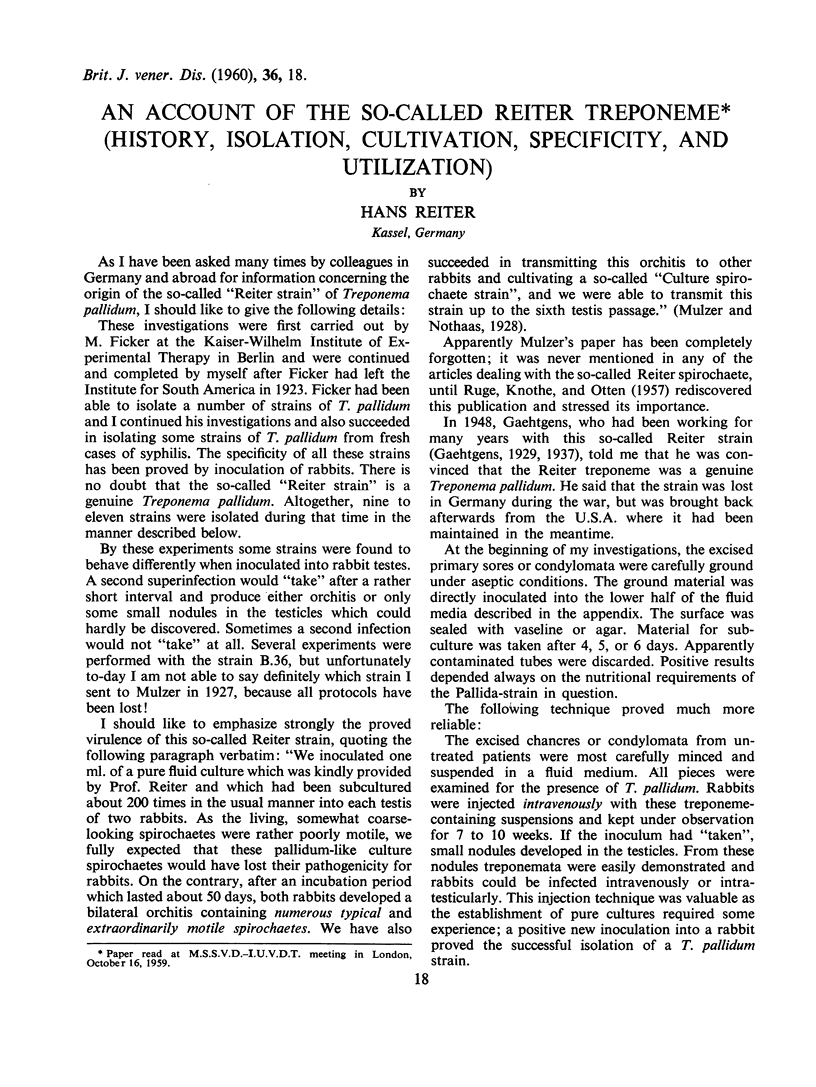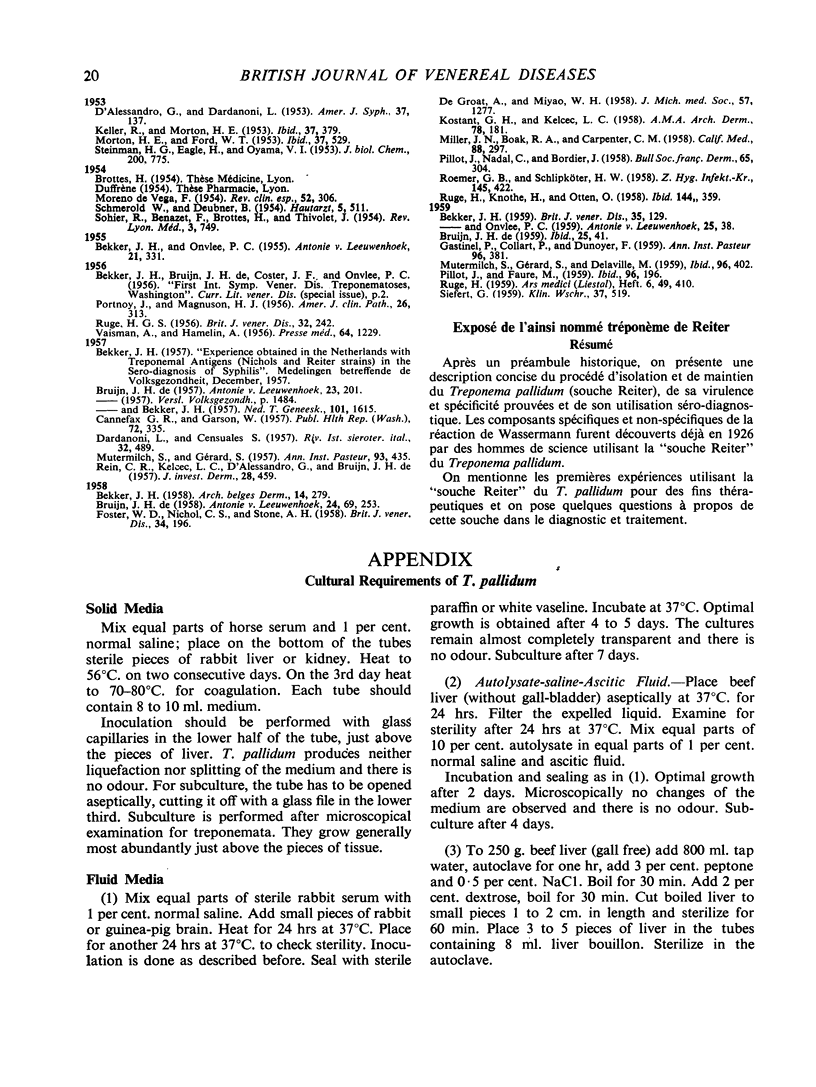Full text
PDF


Selected References
These references are in PubMed. This may not be the complete list of references from this article.
- BEKKER J. H., ONVLEE P. C. Experiences with the treponemal immobilization test in the Netherlands. Antonie Van Leeuwenhoek. 1955;21(3):331–336. doi: 10.1007/BF02543829. [DOI] [PubMed] [Google Scholar]
- BEKKER J. H. Specificity and sensitivity of the Reiter protein complement-fixation (RPCF) test. Report on 1,400 selected sera. Br J Vener Dis. 1959 Jun;35:129–131. doi: 10.1136/sti.35.2.129. [DOI] [PMC free article] [PubMed] [Google Scholar]
- CANNEFAX G. R., GARSON W. Reiter protein complement fixation test for syphilis. Public Health Rep. 1957 Apr;72(4):335–340. [PMC free article] [PubMed] [Google Scholar]
- D'ALESSANDRO G., DARDANONI L. L'antigene proteico del Treponema di Reiter. Riv Ist Sieroter Ital. 1952 May-Jun;27(3):153–172. [PubMed] [Google Scholar]
- D'ALESSANDRO G., ODDO F. G., DARDANONI L. The antigens of the cultured Treponema pallidum (Reiter's strain) and the antispirochetal antibodies in human syphilis. J Vener Dis Inf. 1950 Dec;31(12):314–315. [PubMed] [Google Scholar]
- DARDANONI L., CENSUALES S. Sugli antigeni di natura proteica dei Treponemi; dimostrazione di un antigene comune all Treponema antigens of a protein type; demonstration of an antigen common to pathogenic Treponema and to Reiter's culturable Treponema. Riv Ist Sieroter Ital. 1957 Nov-Dec;32(6):489–500. [PubMed] [Google Scholar]
- DE BRUIJN J. H., BEKKER J. H. Nieuwe methoden bij de serologische syfilis-diagnostiek. III. De toepassing van een eiwit-antigeen van Treponema pallidum (reiter-stam) bij de complementbindingsreactie. Ned Tijdschr Geneeskd. 1957 Aug 31;101(35):1615–1617. [PubMed] [Google Scholar]
- DE BRUIJN J. H. The application of a protein fraction derived from Treponema pallidum (Reiter strain) as an antigen in the serodiagnosis of syphilis. Antonie Van Leeuwenhoek. 1957;23(2):201–206. doi: 10.1007/BF02545871. [DOI] [PubMed] [Google Scholar]
- DEGROAT A., MIYAO W. H. Reiter treponemal antigen in the diagnosis of syphilis and in the evaluation of biological false positive reactions. J Mich State Med Soc. 1958 Sep;57(9 Pt 1):1277–1278. [PubMed] [Google Scholar]
- Eagle H., Steinman H. G. The Nutritional Requirements of Treponemata: I. Arginine, Acetic Acid, Sulfur-containing Compounds, and Serum Albumin as Essential Growth-promoting Factors for the Reiter Treponeme. J Bacteriol. 1948 Aug;56(2):163–176. [PMC free article] [PubMed] [Google Scholar]
- FOSTER W. D., NICOL C. S., STONE A. H. Reiter's protein complement-fixation test; report of a trial in 1,000 unselected cases. Br J Vener Dis. 1958 Sep;34(3):196–197. doi: 10.1136/sti.34.3.196. [DOI] [PMC free article] [PubMed] [Google Scholar]
- GASTINEL P., COLLART P., DUNOYER F. Etude sur le comportement du tréponeme de Reiter en milieu pénicilliné. Ann Inst Pasteur (Paris) 1959 Apr;96(4):381–401. [PubMed] [Google Scholar]
- HAMELIN A., VAISMAN A. L'antigène tréponémique de Reiter dans le sérodiagnostic de la syphilis. Presse Med. 1956 Jun 30;64(52):1229–1229. [PubMed] [Google Scholar]
- KELLER R., MORTON H. E. Susceptibilities of Kazan, Nichols, and Reiter strains of Treponema and pleuropneumonia-like organisms to the antibiotic erythromycin (ilotycin). Am J Syph Gonorrhea Vener Dis. 1953 Jul;37(4):379–382. [PubMed] [Google Scholar]
- KOSTANT G. H., KELEC L. C. An effective simplified serologic test for syphilis employing Reiter protein. AMA Arch Derm. 1958 Aug;78(2):181–185. doi: 10.1001/archderm.1958.01560080039006. [DOI] [PubMed] [Google Scholar]
- MILLER J. N., BOAK R. A., CARPENTER C. M. Reiter protein complement fixation test; a preliminary comparison of the TPI test with the complement fixation test employing a soluble protein antigen derived from the Reiter strain. Calif Med. 1958 Apr;88(4):297–299. [PMC free article] [PubMed] [Google Scholar]
- MORENO DE VEGA F. Luodiagnóstico por la reacción de fijación del complemento con suspensión de treponemas de Reiter. Rev Clin Esp. 1954 Mar 15;52(5):306–309. [PubMed] [Google Scholar]
- MORTON H. E., FORD W. T. Preliminary observations of the action of penicillin on Treponema pallidum in vivo. Am J Syph Gonorrhea Vener Dis. 1953 Nov;37(6):529–535. [PubMed] [Google Scholar]
- MORTON H. E., OSKAY J. Electron microscope studies of treponemes; the effect of penicillin on the Nichols strain of Treponema pallidum. Am J Syph Gonorrhea Vener Dis. 1950 Jan;34(1):34-9, illust. [PubMed] [Google Scholar]
- MUTERMILCH S., GERARD S. Action de divers antibiotiques sur le Tréponème de Reiter; test d'activité possible de ces antibiotiques dans la syphilis. Ann Inst Pasteur (Paris) 1957 Oct;93(4):435–449. [PubMed] [Google Scholar]
- PILLOT J., NADAL C., BORDIER J. Emploi systématique des antigènes tréponémiques dans la sérologie de la syphilis: comparaison de deux types de préparations. Bull Soc Fr Dermatol Syphiligr. 1958 Jun-Jul;65(3):304–307. [PubMed] [Google Scholar]
- PORTNOY J., MAGNUSON H. J. Treponema pallidum complement-fixation (TPCF) test for syphilis. Am J Clin Pathol. 1956 Mar;26(3):313–322. doi: 10.1093/ajcp/26.3_ts.313. [DOI] [PubMed] [Google Scholar]
- PUCCINELLI V. Plurality of antibodies in syphilitic serum and clinical practice. Br J Vener Dis. 1952 Dec;28(4):184–188. doi: 10.1136/sti.28.4.184. [DOI] [PMC free article] [PubMed] [Google Scholar]
- REIN C. R., KELCEC L. C., D'ALESSANDRO G., DE BRUIJN J. H. Sensitivity and specificity of Reiter protein complement-fixation (RPCF) test for syphilis. J Invest Dermatol. 1957 Jun;28(6):459–462. doi: 10.1038/jid.1957.61. [DOI] [PubMed] [Google Scholar]
- ROEMER G. B., SCHLIPKOTER H. W. Die Spirochätenagglutination im Serum, ein Beitrag zur Serodiagnose der Lues. Z Hyg Infektionskr. 1958;145(4):422–438. [PubMed] [Google Scholar]
- RUGE H. G. Role of Treponema Reiter in modern serology of syphilis. Br J Vener Dis. 1956 Dec;32(4):242–245. doi: 10.1136/sti.32.4.242. [DOI] [PMC free article] [PubMed] [Google Scholar]
- RUGE H., KNOTHE H., OTTEN O. Die Pallida-Reaktion; ihre Bedeutung für die moderne Lues-Serologie. Dtsch Med Wochenschr. 1957 Jul 26;82(30):1231–1232. doi: 10.1055/s-0028-1116859. [DOI] [PubMed] [Google Scholar]
- RUGE H., KNOTHE H., OTTEN O. Erfahrungen mit der Pallida-Reaktion; Ihre Bedeutung für die Luesserologie. Z Hyg Infektionskr. 1958;144(4):359–371. [PubMed] [Google Scholar]
- SCARPA C. Spirochete di Reiter e penicillina in vitro. Riv Ist Sieroter Ital. 1949 Oct-Dec;24(4):244–248. [PubMed] [Google Scholar]
- SIEFERT G. Neue Untersuchungen über Antigenfraktionen der Syphilis-spirochäte und ihre Bedeutung für die Lues-Diagnostik. Klin Wochenschr. 1959 May 1;37(9):519–523. doi: 10.1007/BF01483820. [DOI] [PubMed] [Google Scholar]
- STEINMAN H. G., EAGLE H. Nutritional requirements of Treponemata. II. Pantothenic acid, glutamine, and phenylalanine as additional growth-promoting factors for the Reiter treponeme. J Bacteriol. 1950 Jul;60(1):57–68. doi: 10.1128/jb.60.1.57-68.1950. [DOI] [PMC free article] [PubMed] [Google Scholar]
- STEINMAN H. G., EAGLE H., OYAMA V. I. Nutritional requirements of Treponemata. IV. The total nitrogen requirements of the Reiter Treponeme. J Biol Chem. 1953 Feb;200(2):775–785. [PubMed] [Google Scholar]
- STEINMAN H. G., EAGLE H., OYAMA V. I. The nutritional requirements of Treponemata. III. A defined medium for cultivation of the Reiter treponeme. J Bacteriol. 1952 Aug;64(2):265–269. doi: 10.1128/jb.64.2.265-269.1952. [DOI] [PMC free article] [PubMed] [Google Scholar]
- VANDEPUTTE J. Influence de la bacitracine, de la terramycine et de la tyrothricine sur la mobilité et la croissance de quelques tréponèmes. Rev Belg Pathol Med Exp. 1951 Mar;20(6):368–374. [PubMed] [Google Scholar]


